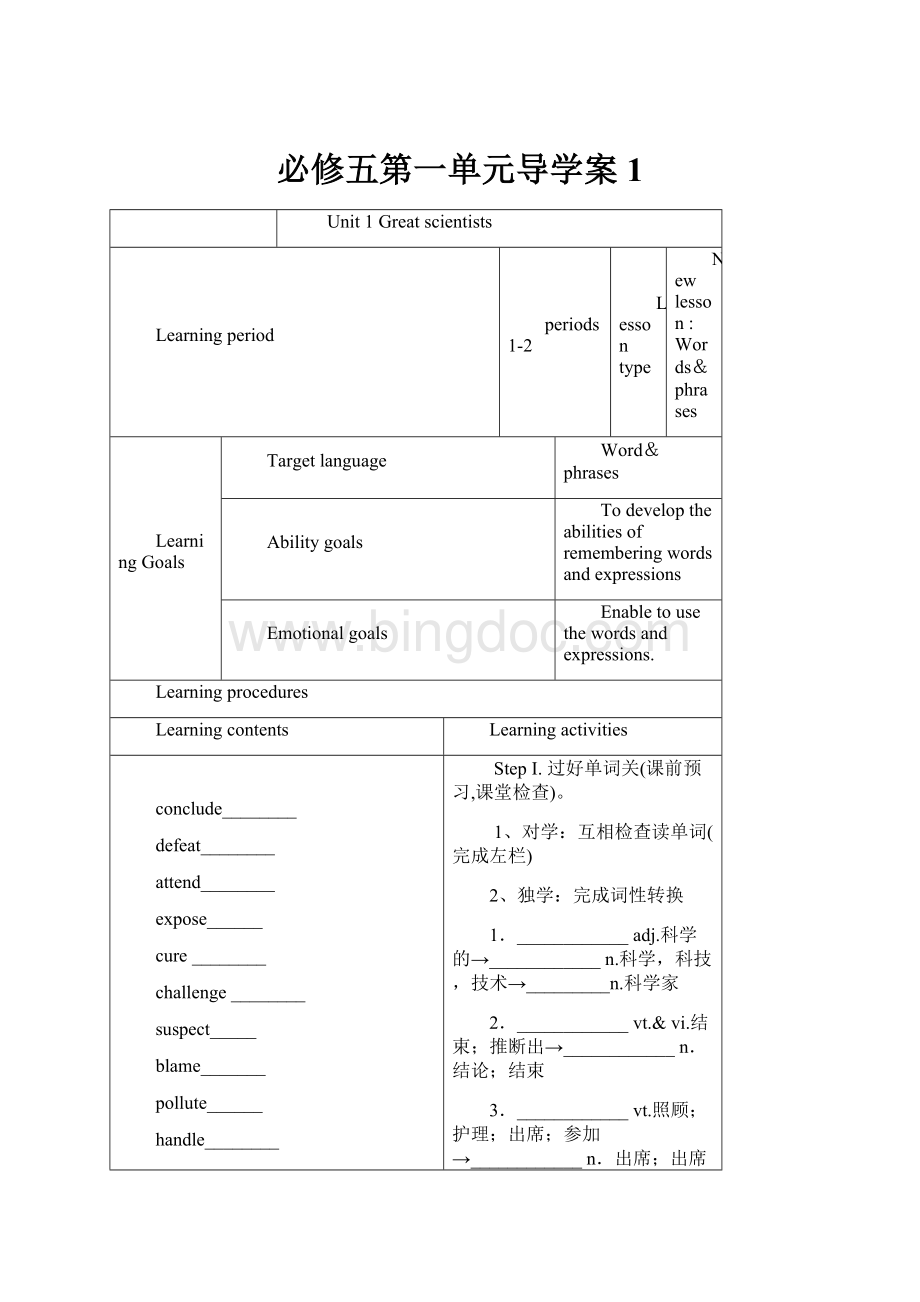必修五第一单元导学案 1.docx
《必修五第一单元导学案 1.docx》由会员分享,可在线阅读,更多相关《必修五第一单元导学案 1.docx(22页珍藏版)》请在冰点文库上搜索。

必修五第一单元导学案1
Unit1Greatscientists
Learningperiod
periods1-2
Lessontype
Newlesson:
Words&phrases
LearningGoals
Targetlanguage
Word&phrases
Abilitygoals
Todeveloptheabilitiesofrememberingwordsandexpressions
Emotionalgoals
Enabletousethewordsandexpressions.
Learningprocedures
Learningcontents
Learningactivities
conclude________
defeat________
attend________
expose______
cure________
challenge________
suspect_____
blame_______
pollute______
handle________
link______
announce_______
contribute_______
reject________
__________特征,特性
_______镭
________画家,油漆匠
___________科学的
____________分析
____专家,行家,
___________内科医师
__________受害者
________吸收,吸引___________询问
____________附近邻近
_______严重的,剧烈的_________预见,预知___________命令,指示
________烟火
__________积极的,
__________移动,运动
_______向后的,相反地____热情的,热心的
_______小心的,谨慎的
_________宇宙,世界
与way相关的短语:
bytheway
bywayof…
loseone’sway
noway
feelone’sway
onone’swayto…
inthisway=bythismeans=withthismethod
与put相关的短语:
putaway
putdown
puton
putoff
putout
putup
putupwith…
StepI.过好单词关(课前预习,课堂检查)。
1、对学:
互相检查读单词(完成左栏)
2、独学:
完成词性转换
1.____________adj.科学的→____________n.科学,科技,技术→_________n.科学家
2.____________vt.&vi.结束;推断出→____________n.结论;结束
3.____________vt.照顾;护理;出席;参加→____________n.出席;出席的人数;照顾→_________n.服务员;出席者;随从
4.____________vt.暴露;揭露;使曝光→_______adj.暴露的,无遮蔽
5.____________vt.吸收;吸引;使专心→____________adj.全神贯注的;一心一意的;被吸收的→_________吸引人的;极有趣的
6.____________vt.污染;弄脏→____________n.污染
7.____________vt.宣布;通告→____________n.宣告;公告→____________n.播音员;宣告者
8.____________vt.命令;指示;教导→____________n.教员;教练;指导员→____________n.吩咐;命令;用法说明;操作指南
3.重点短语
1.________________提出2.________________得出结论
3.________________使显露;暴露4.________________面对挑战
5.________________该受责备;应负责6.________________将……和……联系起来
7.________________除……之外;此外8.________________对……严格的
StepII.(课堂探究交流)Warmingup:
1.Playgames:
let’sguesswhoheorsheisaccordingtosomeinformation.
(1)Hehasmadeafamouskiteexperiment.
Helearnedalotfromitandinventedlightningrod(避雷针).
Heis____________
(2)Heiscalledthegreatestscientistinthe20thcentury.
HeisfamousfortheTheoryofRelativity.
Heis____________
(3)Hemadethefirsttelescopeintheworld.
Hisobservationsshowthattheearthmovesaroundthesun.
Heis____________
2.Whatdoyouknowaboutgreatscientists?
Trythisquizandfindoutwhoknowsthemost.
(1).Whichscientistdiscoveredthatobjectsinwaterareliftedupbyaforcethathelpsthemfloat?
(2).Whowroteabookexplaininghowanimalsandplantsdevelopedastheenvironmentchanged?
(3).Whoinventedthefirststeamengine?
(4).Whousedpeastoshowhowphysicalcharacteristicsarepassedfromparentstotheirchildren?
(5).Whodiscoveredradium?
(6).Whoinventedthewayofgivingelectricitytoeverybodyinlargecities?
(7.)Whowasthepainterthatstudieddeadbodiestoimprovehispaintingofpeople?
(8).Whoinventedalamptokeepminerssafeunderground?
(9).Whoinventedtheearliestinstrumenttotellpeoplewhereearthquakeshappened?
(10).Whoputforwardatheoryaboutblackhole?
Step3:
LanguagePoints
1.discover&invent
inventv.发明,发明原先不存在的东西
Whoinventedthesteamengine?
谁发明了蒸汽机?
discoverv.发现,探索或揭示早就客观存在着事物
ColumbusdiscoveredAmericain1492.哥伦布于1492年发现了美洲。
Whodiscoveredradium?
谁发现了镭?
2.explainexplainsth.tosb.
3.characteristicn./adj.
Somegeneticcharacteristicsarenotobvious.
Thetwogroupsofchildrenhavequitedifferentcharacteristics.
Forgetfulnessisoftencharacteristicofagedpeople.
4.passsthfrom…从…处传来,传下
passby__________passdown____________passon______________
1)Thetraditionis___________theirancestors.
2)Thisspiritshouldbepassed______fromgenerationtogeneration.
3)Passtheletter___tothepersonnexttoyou.
4)Somanypeoplepass___andnevernoticethechange.
5.Whoinventedthewayofgivingelectricitytoeverybodyinlargecities?
是谁发明了把电带给大城市中的每个人的办法?
thewayofdoingsth.=thewaytodo…“做…..的方法”
Sheshowedusthewayofcleaningit.=Sheshowedusthewaytocleanit.
她给我们示范清洗它的办法.
theway引导的定语从句的引导词有三种,可以用that;可以用inwhich;还可以省略.
Idon’tliketheway_______________youspeaktoyourfather.
我不喜欢你跟你父亲讲话的方式.
______________
6.Whoputforwardatheoryaboutblackholes?
谁提出了黑洞的理论?
putforward
(1)提出(建议等)
(2)推荐某人或自己任职位;提名
我能否提名你当我们的班长?
MayI________________________asourmonitor?
他在会议上提出了一个计划。
___________________________________________
他们把婚礼的日期提前了一周。
_______________________________________byoneweek.
Reflection
Subjectline
Unit1Greatscientists
Learningperiod
Periods3-4
Lessontype
Newlesson:
readingandLanguagepointsinreading
LearningGoals
Targetlanguage
Reading,speakingandwriting
Abilitygoals
DeveloptheSs’abilitiesofreading
Emotionalgoals
EnabletheSstoTalkaboutthegreatscientist’sachievement
Teachingprocedures
Learningcontents
Learningactivities
1.Neitheritscausenoritscurewasunderstood.
neither...nor...“既不……也不……”,连接句中两个相同的句子成分。
连接主语时,谓语动词遵循
(2) 原则遵循就近一致原则的其他并列连词:
either...or不是……就是……
notonly...butalso..不仅而且……
not...but...不是……而是……
2.everytime是名词短语充当连词,用来引导
(2) 状语从句。
相当于whenever,意思是“每当……”。
可用作连词,引导时间状语从句的名词短语还有eachtime,anytime,thelasttime,,nexttime,thefirsttime,themoment,thesecond,theminute
3.suggest(tosb)that...意为“(向某人)建议……”,此时that从句中的谓语动词要用“
(2) ”形式,should可以省略。
suggest还可以表示“暗示;表明”之意,此时根据语境选用合适的时态。
suggestdoingsth建议……suggestsb/sb’sdoingsth建议某人做某事(不说suggestsbtodosth)suggeststhtosb向某人提议……(不说suggestsbsth)
Itissuggestedthat...建议……(拟语气)suggestionn.与其相关的名词性从句用虚拟语气(should+动词原形,should可以省略)。
4.“only+状语”置于句首时,句子要使用
(2) only置于句首修饰作状语的副词或介词短语时,句子要倒装。
only置于句首修饰状语从句时,主句要用倒装语序,从句不用倒装语序。
Step1--Ⅰ.Pre-reading
1.Brainstorming:
Therearesomegreatscientificachievementsthathavechangedtheworld.Doyouknowthem?
Matchtheinventionswiththeirinventorsbelow.
(1)AlexanderBell A.Electricity
(2)ThomasEdisonB.TheFirstTelephone
(3)WrightBrothersC.TheElectricLamp
(4)MadameCurieD.BlackHolesintheUniverse
(5)FranklinE.TheoryofGravity
(6)StephenHawkingF.TheFirstPlane
(7)AlbertEinsteinG.Radium
(8)IsaacNewtonH.TheoryofRelativity
2.Testyourself:
Fillintheformsaccordingtothepassage.
Stage1
Findaproblem
Alargenumberofpeoplediedofcholera,butneitherits
(1) norits
(2) wasunderstood.
Stage2
Makeupaquestion
◆Theoryone:
Cholera(3) intheairandfloatedarounduntilitfounditsvictims.
◆Theorytwo:
Whenpeople(4) choleraintotheirbodieswithmeals,theirbodieswereattacked.
Stage3
Thinkofamethod
Begantogatherinformationto(5) thatthesecondtheorywascorrect.
Stage4
Collectresults
Markedwherethedeadpeoplehadlivedona(n)(6) .
Stage5
Analyzetheresults
Lookedintothe(7) ofthewatertoseeiftheproblemwasthewater.
3.Howcanascientistproveanewideainthescientificresearch?
Discussingroups.Thenlisttheorderofthestepsofthescientificresearch.
①Collectresults ⑤Findsupportingevidence
②Makeupaquestion ⑥Repeatifnecessary
③Drawaconclusion ⑦Findaproblem
④Thinkofamethod ⑧Analyzetheresults
Ⅱ.Fastreading:
Readthetextquicklyandanswerthefollowingquestions.
1.WhatwouldtheLondonersdowiththeunusedpumpsafterdefeating“KingCholera”?
2.Whathappenedin1854?
3.WhywastherenodeathatNo.20and21BroadStreetaswellasatNo.8and9CambridgeStreet?
4.Whycouldn’tthecholerabeundercontrolatfirst?
5.Whatarethetwotheoriesthatexplainedhowcholerakilledpeople?
Ⅲ.Carefulreading:
Readthetextcarefullyandchoosethebestanswers.
1.WhatconclusiondidJohnSnowdrawaccordingtotheevidence?
A.Choleramultipliedinthewater.
B.Pollutedwatercarriedthevirus.
C.Acloudofdangerousgascausedcholera.
D.Choleracouldneverbecontrolledeventhoughitscausewasfound.
2.Fromthetext,wecanlearnthat .
A.choleraneverbrokeoutintheworld
B.JohnSnowwasgoodatdrawingmaps
C.JohnSnowcamefromanordinaryfamily
D.carefulinvestigationsareveryimportantinsolvingproblems
3.Whatwastheoriginalsourceof“KingCholera”?
Acloudofdangerousgas.B.Thespreadingofvirusamongpeople.
C.WaterinacertainpumpinLondon.D.Ariverpollutedbythedirtywater.
4.FromJohnSnowsfindingswecaninfer .
A.thenearerpeoplelivedtothepump,themoredeathsappeared
B.thefartherawaypeoplelivedfromthepump,themoredeathsappeared
C.peoplewholikebeerdidn’thavethedisease
D.beerwasacuretothedisease
5.JohnSnowfinallyprovedthetheoryhebelievedby .
A.gatheringinformationwiththehelpofamap
B.lookingintothesourceofthewaterforBroadStreetandCambridgeStreet
C.separatingthosewhosufferedcholerafromthosewhodidn’t
D.bothAandB
Ⅳ.Postreading
1.Fillineachblankwithonlyonewordandthenretellthetext.
InthetimesofQueenVictoria,theso-called“KingCholera”hitLondoners,
(1) oftenresultedinlargenumbersofdeaths.Butnobodycouldfindthecauseofcholera,orthe
(2) forit.JohnSnow,whowasawell(3) (know)doctorthen,tookthe(4) andwantedto(5) theproblem.Hegathered(6) fromtheseverecholeraoutbreakandfinallyfounditwasthe(7) (pollute)waterthatcausedcholera.Sothe(8) ofallthewatersupplieswasexamined(9) (immediate).“KingCholera”was(10) intheend.
Languagepoints:
drawaconclusion得出结论draw/cometo/arriveat/reachaconclusion(from…)
v.conclude结束;推断出
eg:
Themeetingconcludedat8o’clock.